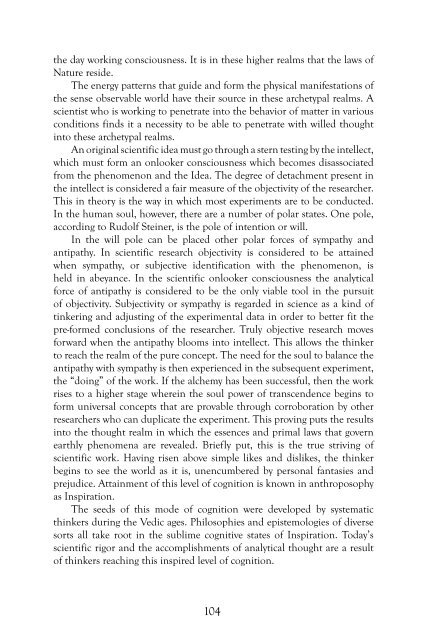When Healing Becomes Educating, Vol. 1 - Waldorf Research Institute
When Healing Becomes Educating, Vol. 1 - Waldorf Research Institute
When Healing Becomes Educating, Vol. 1 - Waldorf Research Institute
Create successful ePaper yourself
Turn your PDF publications into a flip-book with our unique Google optimized e-Paper software.
the day working consciousness. It is in these higher realms that the laws of<br />
Nature reside.<br />
The energy patterns that guide and form the physical manifestations of<br />
the sense observable world have their source in these archetypal realms. A<br />
scientist who is working to penetrate into the behavior of matter in various<br />
conditions finds it a necessity to be able to penetrate with willed thought<br />
into these archetypal realms.<br />
An original scientific idea must go through a stern testing by the intellect,<br />
which must form an onlooker consciousness which becomes disassociated<br />
from the phenomenon and the Idea. The degree of detachment present in<br />
the intellect is considered a fair measure of the objectivity of the researcher.<br />
This in theory is the way in which most experiments are to be conducted.<br />
In the human soul, however, there are a number of polar states. One pole,<br />
according to Rudolf Steiner, is the pole of intention or will.<br />
In the will pole can be placed other polar forces of sympathy and<br />
antipathy. In scientific research objectivity is considered to be attained<br />
when sympathy, or subjective identification with the phenomenon, is<br />
held in abeyance. In the scientific onlooker consciousness the analytical<br />
force of antipathy is considered to be the only viable tool in the pursuit<br />
of objectivity. Subjectivity or sympathy is regarded in science as a kind of<br />
tinkering and adjusting of the experimental data in order to better fit the<br />
pre-formed conclusions of the researcher. Truly objective research moves<br />
forward when the antipathy blooms into intellect. This allows the thinker<br />
to reach the realm of the pure concept. The need for the soul to balance the<br />
antipathy with sympathy is then experienced in the subsequent experiment,<br />
the “doing” of the work. If the alchemy has been successful, then the work<br />
rises to a higher stage wherein the soul power of transcendence begins to<br />
form universal concepts that are provable through corroboration by other<br />
researchers who can duplicate the experiment. This proving puts the results<br />
into the thought realm in which the essences and primal laws that govern<br />
earthly phenomena are revealed. Briefly put, this is the true striving of<br />
scientific work. Having risen above simple likes and dislikes, the thinker<br />
begins to see the world as it is, unencumbered by personal fantasies and<br />
prejudice. Attainment of this level of cognition is known in anthroposophy<br />
as Inspiration.<br />
The seeds of this mode of cognition were developed by systematic<br />
thinkers during the Vedic ages. Philosophies and epistemologies of diverse<br />
sorts all take root in the sublime cognitive states of Inspiration. Today’s<br />
scientific rigor and the accomplishments of analytical thought are a result<br />
of thinkers reaching this inspired level of cognition.<br />
104

















